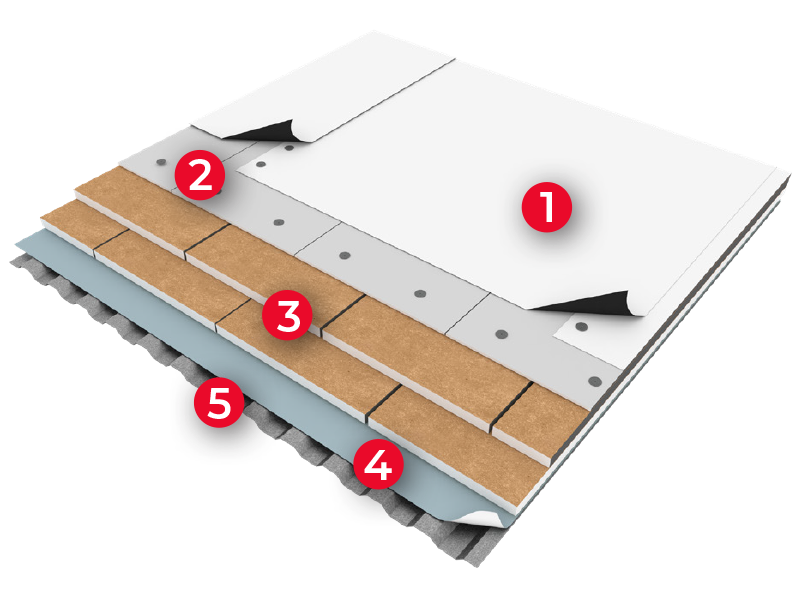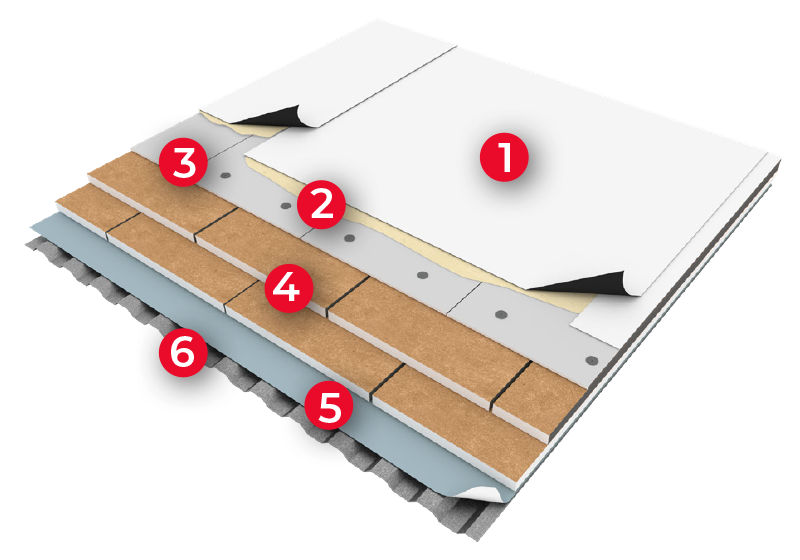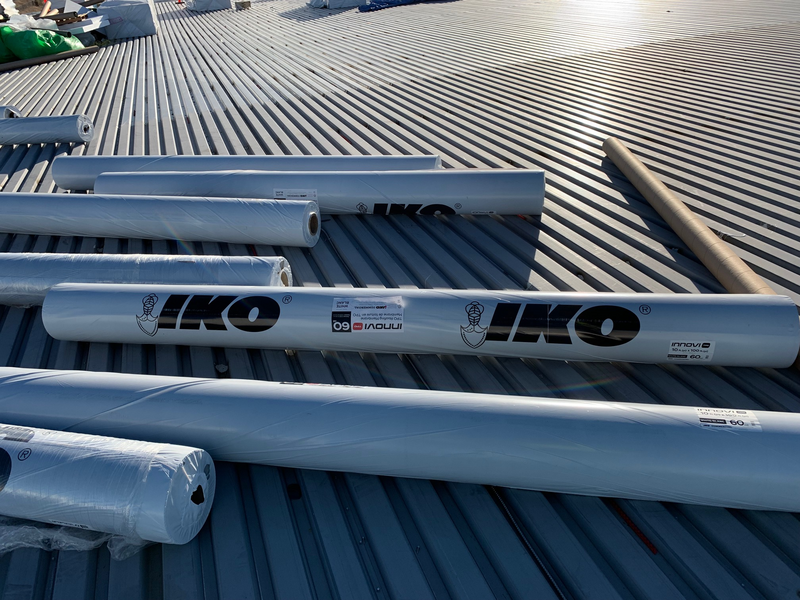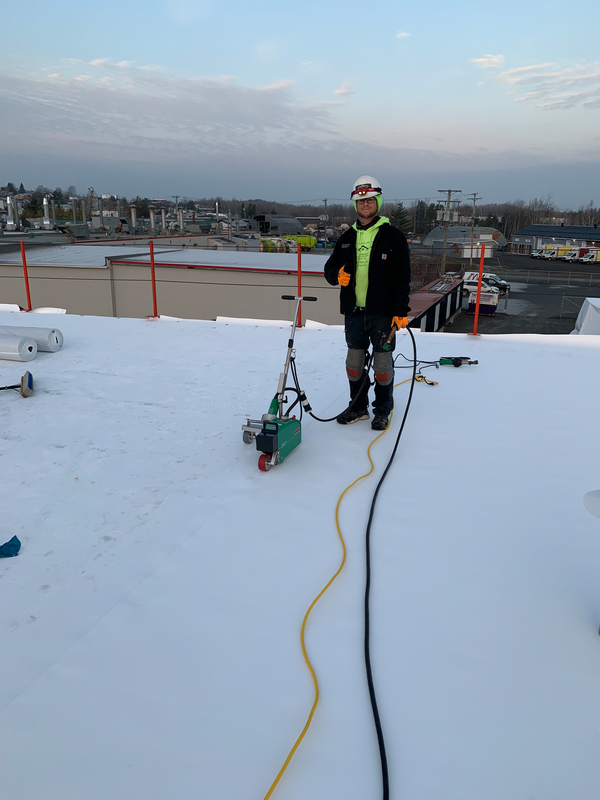What Is TPO Roofing?
TPO commercial roofing membranes were first specified in Europe, then made significant inroads in the North American market in the late 1990s. Since then, there have been many developments in the low-slope (flat) roofing industry. Now, TPO commands a considerable market share in the U.S. and Canada, with the market valued at USD 4.57 billion in 2021.
According to a Single Ply Roofing Industry (SPRI) news release on May 31, 2022, thermoplastic membranes saw a 14% growth in 2021 over the prior year.
What is a TPO roof membrane?
TPO is a thermoplastic polyolefin membrane with a polyester reinforcement scrim. There is an ASTM D6878 specification that outlines test methods to measure several criteria, including thickness over scrim, sheet tearing strength, physical properties after heat aging and weather resistance.
TPO also achieves high results in ASTM tests for radiative properties, including solar reflectance and thermal emittance, TPO membranes provide some of the highest Solar Reflective Index (SRI) ratings among commercial roofing membranes. TPO roofs can also qualify for LEED credits.
How does TPO compare to other commercial roofing materials?
TPO is a valued commercial product because it has the following benefits:
- TPO meets or exceeds a variety of ASTM standards for weathering resistance.
- TPO membranes are durable and long-lasting.
- TPO manufacturers offer warranties for up to 30 years.
- White TPO’s reflectivity, emissivity and SRI meet general industry radiative performance standards, such as LEED certification and can be used to comply with California Title 24, Part 6 (Cool Roof).
- TPO demonstrates flexible characteristics for successful installation and exceptional weld capabilities within a wide-temperature window.
- No chlorine or halogenated compounds are in the formulation.
- TPO is budget-friendly.
- TPO is inherently puncture-resistant for low maintenance.
- TPO is easy to repair due to its ability to heat-weld rapidly. Heat-welding creates a chemical bond that becomes the strongest part of the membrane.
How is TPO roofing installed?
There are three main TPO roofing assemblies:
Mechanically Attached TPO Roofing System
- IKO InnoviTPO Membrane.
- IKOTherm CoverShield.
- IKOTherm Insulation.
- IKO MVP Vapor Barrier (Optional).
- Approved Roof Deck.
Mechanically attached systems are cost-effective. Because adhesives are not used in the field of the roof, there are fewer application temperature restrictions.

Adhered TPO Roofing System
- IKO InnoviTPO Membrane.
- InnoviBond Membrane Adhesive.
- IKOTherm CoverShield.
- IKOTherm Insulation.
- IKO MVP Vapor Retarder (Optional).
- Approved Roof Deck.
Adhered systems evenly distribute uplift pressures on the membrane and substrate, resulting in optimal wind uplift code approvals. They also allow the use of the widest sheets, reducing seams.

Induction-Welded TPO Roofing System
- IKO InnoviTPO Membrane.
- IKOTherm CoverShield.
- IKOTherm Insulation.
- IKO MVP Vapor Retarder (Optional).
- Approved Roof Deck.
Induction-welded systems are highly efficient and are an excellent choice for large-scale roofing applications, helping to reduce labor costs. They also receive outstanding wind uplift resistance ratings due to the point-loading benefits of this assembly.

What Thicknesses of TPO Are Available?
IKO InnoviTPO is available in 45-mil (0.045 inch), 60-mil (0.060 inch) and 80-mil (0.080 inch) thicknesses.
What size rolls are available for TPO roofing?
Stocked roll sizes for InnoviTPO are 5 feet by 100 feet (1.5 m x 30.5 m), 10 feet by 100 feet (3.0 m x 30.5 m) and 12 feet by 100 feet (3.8 m x 30.5 m) for white, grey and tan 45-mil, 60-mil and 80-mil TPO.
For white, grey and tan 45-mil and 60-mil membranes, 6 feet by 100 feet (1.9 m x 30.5 m) and 8 feet by 100 feet (2.4 m x 30.5 m) rolls are available.
White TPO is also available for 60-mil TPO in 10 feet by 200 feet (3.0 m x 61 m) rolls.
What are the benefits of a white TPO membrane?
IKO Commercial manufactures white TPO to provide maximum solar reflectance and to meet industry emissivity and SRI performance standards. It can be considered for LEED credits.
Does the TPO roofing have to be white?
No, IKO Commercial also supplies grey and tan TPO for design and aesthetic requirements. Reflectivity and emissivity performance will differ from white.
What is the reflectivity of a white TPO roofing membrane?
According to the Cool Roof Rating Council (CRRC) test methods, white IKO InnoviTPO has solar reflectance values of 0.78/Initial and 0.73/3-yr Aged, thermal emittance values of 0.89/Initial, 0.88/3-yr Aged, and Solar Reflectance Index (SRI) values of 97/Initial, 90/3-yr Aged.
Does a TPO roof need UV protectant spray?
IKO InnoviTPO roofs do not need UV protectant spray. Ultraviolet inhibitors are components in the chemistry of the InnoviTPO Matrix formulation.
Does TPO membrane meet ASTM D412?
ASTM D412 is not a test applied to TPO. It is more commonly used to test EPDM tensile strength. ASTM D6878 requires tests for the breaking strength and tearing strength of the TPO roofing membrane per the ASTM D751 standard test method. IKO InnoviTPO exceeds the D751 test criteria for these tests.
Is TPO roofing FBC approved?
Roofing systems have been tested and have demonstrated compliance with the 7th Edition (2020) Florida Building Code in the categories of wind resistance, impact resistance, physical properties and material standards. IKO InnoviTPO is listed in Florida Building Code Product Approvals, along with several specific roofing assemblies; contact IKO Commercial Technical Services for further information.
What is the IKO Innovi Matrix formulation?
Matrix is a breakthrough chemistry with strong antioxidant and UV-resistant components that underly IKO InnoviTPO’s weatherability. The manufacturing process enhances the proprietary formulation as it is processed into a TPO sheet.
Can TPO roofs qualify for warranties?
IKO InnoviTPO can qualify for IKO Diamond Shield Limited Warranty protection when installed by an IAAP (IKO Approved Applicator Program) Certified Installer and inspected by an IKO Commercial Field Service Technician. You can find out more about the IAAP program and how to become IAAP certified by visiting the Training & Education page on the IKO Commercial website.
Can TPO and polyiso insulation be ordered together?
Yes, IKO Commercial can ship both products from the same manufacturing facility in Hagerstown, Maryland. TPO roofing membrane, polyiso insulation, and roofing accessories (flashings, fastening products, adhesives, sealants, etc.) are typically ordered together to install a complete roofing system.
What do contractors like about IKO InnoviTPO?
Roofing contractors frequently state that InnoviTPO welds quickly and easily. The wide weld window ensures optimal installation in a variety of conditions. IKO InnoviTPO has outstanding dimensional stability and tear strength. Its inherent flexibility enables it to lay flat for easy seaming, easy cutting and easy vertical application, potentially lowering labor costs on the roof.
What is the maximum slope for TPO roofing?
The maximum allowable slope varies according to the application method. There is no maximum slope limit for fully adhered membranes. The maximum slope for mechanically attached and induction-welded membranes is 4:12 inches (33%). For ballasted membranes, 2:12 inches (16.6%) is the maximum slope.
What is the minimum slope requirement for TPO roofing installation?
The International Building Code® 2018 Edition prescribes a ¼:12 minimum for thermoplastic single-ply in new construction. Positive slope to drain is always required in any roofing project design, whether accomplished through structural slope or the use of tapered insulation.
Can TPO roofing be installed in cold weather?
Yes, it can, although installations in cold weather require special considerations, and primers, adhesives and sealants cannot be used below specific temperatures. Welding also requires careful calibration in cold weather. See the IKO Installation Manual, Sections 1.2-3 “Cold Weather,” and 3-2 “TPO Membrane Seaming,” and relevant Product Data Sheets for further information.
Can TPO roofing be installed over plywood?
TPO roofing systems can be installed over a variety of wood deck types, including plywood, OSB and wood plank. Direct application of the membrane is not recommended; a separating layer of IKOTherm polyiso insulation should be used. Minimum thicknesses of the wood deck are required; please see the IKO Roofing Systems Attachment Guide for further information.
Can a TPO roof be painted?
TPO roofing membrane should not be painted. Only products designed for use with TPO membrane should be used for roofing repairs, and only a roofing professional should perform any repairs.
Can TPO be applied with a torch?
No, TPO is not applied with torches.
Does TPO have to be heat-welded?
IKO InnoviTPO is heat-welded at all seams using specialized hot-air equipment. On the IKO website, there are extensive guidelines for proper seaming. IKO technical representatives are also available to answer any questions for a specific project.
Can I use a broom on a TPO roof?
Yes, a floor broom or a soft-bristle brush is recommended for routine maintenance and upkeep to maintain a clean surface on a TPO roof.
Are corner cants needed for a TPO roof?
Cant strips are not necessary for single-ply roofing membranes. Single-ply membranes can be turned directly up with angle changes. See IKO technical information for complete instructions and roofing details regarding base tie-ins and vertical application.
Can you weld TPO to PVC?
Dissimilar single-ply membranes cannot be welded or adhered together. Tying in adjacent areas of different membranes can be accomplished using special details that terminate each system and keep them separate. See IKO technical information in Section 3-3 of the Installation Manual for instructions and details on base tie-ins.
How much bonding adhesive is needed for TPO fully adhered roof installation?
The amount of bonding adhesive needed varies with the type of adhesive used. IKO Commercial offers three bonding adhesive options: standard solvent-based/roller-applied, low volatile organic content (LVOC) roller-applied and low VOC sprayable. Refer to IKO’s technical requirements in Section 3-1.1, Paragraph E, for individual roofing projects.



